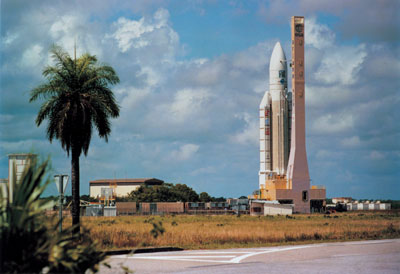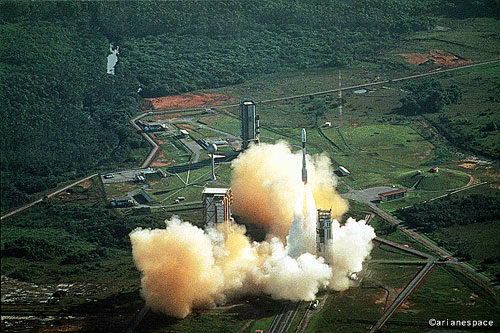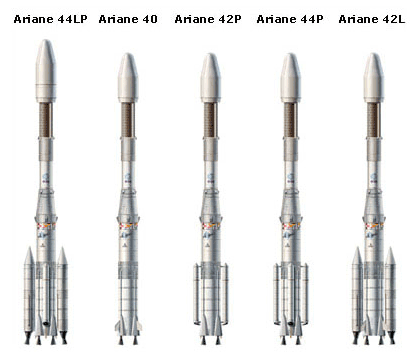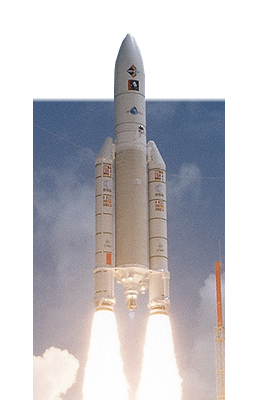Le coin des amatheurs de sciences version 2 
The sections of the site : The site  FORUM
FORUM  The space
The space  The genetics
The genetics  Medicine
Medicine  Physics
Physics  Tintin and science
Tintin and science  Ecology - Nuclear energy
Ecology - Nuclear energy  Mysteries of the history
Mysteries of the history  Humour
Humour  Diverse
Diverse
Le coin des amatheurs de sciences version 2 
The sections of the site : The site  FORUM
FORUM  The space
The space  The genetics
The genetics  Medicine
Medicine  Physics
Physics  Tintin and science
Tintin and science  Ecology - Nuclear energy
Ecology - Nuclear energy  Mysteries of the history
Mysteries of the history  Humour
Humour  Diverse
Diverse
 The purpose of the Ariane program is launching of satellites in geostationary orbit of transfer, except for Ariane 5 the purpose of which is also the transfer of important loads in low orbit. The program was born for several reasons. First of all, France had become in 1965 the third space power thanks to the rocket Diamant A1 and with the satellite A1 (or Astérix). Then, Europa already had a project of common launcher but the program trampled. It was thus determined to put the European program under the control of France, it was the birth of Ariane, launched in 1973.
The purpose of the Ariane program is launching of satellites in geostationary orbit of transfer, except for Ariane 5 the purpose of which is also the transfer of important loads in low orbit. The program was born for several reasons. First of all, France had become in 1965 the third space power thanks to the rocket Diamant A1 and with the satellite A1 (or Astérix). Then, Europa already had a project of common launcher but the program trampled. It was thus determined to put the European program under the control of France, it was the birth of Ariane, launched in 1973.
The program is the collaboration of five organizations :
- the European Space Agency (ESA) and the National Center of Space Studies (CNES) decide missions entrusted to the Ariane rocket.
- Aerospace factory the rocket by assembling the parts coming from all the countries of the program.
- Arianespace (creates in 1980) manages the commercial exploitation.
- The base of Kourou, from where all the Ariane.
Download the list of Ariane's flights. If you can't read PDFs, go to the page of links.
Ariane 1
This first launcher was not very advanced and only two to four throws per annum were envisaged. The rocket comprised three stages and measured 47,7 m for a weight of 210 tons. It could transport up to 1,85 tons.
The first rocket took off on December 24, 1979 and makes a success of its mission. However, the second shooting (May 23, 1980) was a failure. Until February 22, 1986, eleven specimens of Ariane 1 were launched, a second failure having been recorded on September 9, 1982.
Ariane 2
In 1986, the rocket is improved : the third stage is lengthened. The rocket measures now 49 m for a weight of 220 tons and it can transport up to 2,175 tons. Six specimens of Ariane 2 took off between May 31, 1986 (it was the only failure) and April 2, 1989.
Ariane 3
This new rocket marks real innovations compared to the preceding ones. Initially, two external engines (PAP for powder strap-on boosters) appear at the base of the first stage. Moreover, one carrying structure (Sylda) allowed the transport of two additional satellites. The mass of the rocket passed to 240 T and the transport capacity to 2,7 tons. Eleven rockets Ariane 3 were launched (first shooting on August 4, 1984, last shooting on July 12, 1989, only one failure - that of September 12, 1985 - being to regret).
Ariane 4
 The modifications made compared to Ariane 3 consist mainly of a lengthening of the first stage thanks to the appearance of a new structure for double launchings or triple (Spelda) and the use of a cap of large diameter, making it possible to place satellites of higher size. The first shooting took place on June 15, 1988.
The modifications made compared to Ariane 3 consist mainly of a lengthening of the first stage thanks to the appearance of a new structure for double launchings or triple (Spelda) and the use of a cap of large diameter, making it possible to place satellites of higher size. The first shooting took place on June 15, 1988.
There are six versions of the rocket. Each version is defined by a number placed after the 4 and if it has PAP, one adds a P. According to the version, the height of the rocket lies between 54,1 and 58,4 m and the mass go 243 tons (Ariane 40) to 480 tons (Ariane 44L).
The program was officially stopped in 2003. The last flight took place on February 15, 2003 (flight 159, model 44L). Ariane 4 carried out 116 flights in 15 years for only 3 failures (February 1990, January 1994 and December 1994). The ESA didn't forget to mark the range symbolic system of the last flight in these words : « the ultimate customer of Ariane 4 was also the very first customer of the die, signing two contracts of launching before even the inaugural flight of Ariane 1. »
 - Ariane 40 (initial version) is deprived of PAP and can transport 2,1 tons.
- Ariane 40 (initial version) is deprived of PAP and can transport 2,1 tons.
- Ariane 42 P has two PAP and can transport 2,93 tons.
- Ariane 44 P has four PAP and has a capacity of 3,46 tons.
- Ariane 42 L (L for two engines with propellants liquidate) can take along 3,48 T.
- Ariane 44 LP (two PAP + two engines with propellants liquidate) has a transport capacity of 4,22 T.
- Ariane 44 L (four engines with propellants liquidate) is most powerful and transports more than 4,7 T towards the geostationary orbit.
Ariane 5
 The starting of the program Ariane 5 was officially decided with the European Ministers conference for La Haye in 1987. It was made to be used as satellite launcher but also shuttle Hermès, project later given up. Ariane 5 is a real revolution compared to its predecessors. It is very flexible and can carry out completely different missions at variable altitudes.
The starting of the program Ariane 5 was officially decided with the European Ministers conference for La Haye in 1987. It was made to be used as satellite launcher but also shuttle Hermès, project later given up. Ariane 5 is a real revolution compared to its predecessors. It is very flexible and can carry out completely different missions at variable altitudes.
There initially were three trial flights. Ariane 501 (June 4, 1996) is a failure. The launcher, incompetent to preserve his trajectory, explodes after 37 seconds. Ariane 502 (October 30, 1997) gives relatively good results, if it is not that one of the engines causes rolling and places the satellite orbits about it too low. Ariane 503 (October 21, 1998) is a success, and allows the design of the final launcher.
The first version, Ariane 5G, consists of a cryogenic principal stage, of two strap-on boosters (EAP) and of a higher stage, that is to say a stage of less than Ariane 1 to 4. Thanks to the structures Speltra (June 4, 1996) and Sylda 5 (March 21, 2000), the rocket can transport two satellites at the same time (Sylda 5 is less heavy than Speltra but transports less large satellites). The ASAP (Ariane Structure for Auxilary Payloads) allows trasnporter in more of the micro satellites (first use : November 16 2000)
The following version, 5G+, has been manufactured only 3 times : it was only a transition version, in order to wait for the launching of the ECA version. The main changes of 5G+ are a bigger tank and best EAPs (used in the ECA version). The design of the ECA launcher has been slower than it was predicted, so one had to prolong the use of the generic launcher. One invented the 5GS version, which is like 5G+ with other EAPs.
The first launching of Ariane 5ECA, also called Ariane 5 « 10 tons » (December 11, 2002) was a failure because of a failure of the engine and was the reason why the program was late. The second try (February 12, 2005) was completely succesful. The principal improvements are the installation of the engine Vulcan 2 (20 % of additional push) and the increase of the pounds of the EAPs (2430 kg more). One obtains a launcher which is more powerful than the generics, it can transport until 10 tons of useful charge. So this version is with ES (see above) the only used one.
First planned for 2006, Ariane 5ES finally flied for the first time (successfully) on March 9th, 2008. This version is mostly destinated to the launches of the ATV, which can't be taken by ECA because it weighs almost 20 tons. So the launcher was developped in the same time that the ATV, with an adapted form, and that's why it's sometimes called Ariane 5ES/ATV. The ATV, Automated Transfer Vehicle, is a vehicle destinated to supply the ISS (international space station) : sent in the atmosphere by Ariane 5, it can join alone the station with food, watter, oxygen, combustible and other furnitures. It then remains attached to the station during six months and its motor can be used to straighten the orbit. At the end of this period, it is detached to lorry garbages. The first ATV was named in homage to Jules Verne.
We finally wait for a last version, Ariane 5ECB, that should be a best version of ECA and should transport 12 tons, but the program is now suspended.